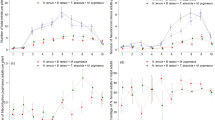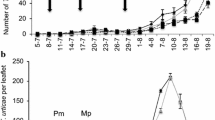Abstract
Invasive species can strongly affect biotic interactions in ecosystems, interacting both directly and indirectly with local species. In European tomato greenhouses, the invasive alien pest Tuta absoluta may impact the population dynamics of other pests like whiteflies. Besides inducing damages to the host plant and competing for resources with local pests, this alien species may exert a predator-mediated interaction on local pests sharing common natural enemies. Biocontrol agents usually used against whiteflies may also prey upon T. absoluta and this could alter the dynamics of local pest populations. We evaluated possible resource competition and predator-mediated interactions in a system involving one mirid predator Macrolophus pygmaeus and two pests, T. absoluta and a local whitefly, Bemisia tabaci, on greenhouse tomatoes. Results showed that both resource competition and predator-mediated interactions occurred simultaneously. In the presence of the shared predator, there was a short-term positive effect of T. absoluta on B. tabaci [up to 5.9-fold increase of B. tabaci juveniles (egg + larvae) after four weeks]. However, in the long-term there was a negative predator-mediated interaction of T. absoluta on B. tabaci, i.e., after ten weeks the density of B. tabaci was 7.3-fold lower in the presence of the invasive pest. We emphasize the critical role of generalist predators in managing both local and invasive alien pest populations and that the strength and direction of predator-mediated indirect interactions can depend on the time scale considered.




Similar content being viewed by others
References
Abrams PA, Matsuda H (1996) Positive indirect effects between prey species that share predators. Ecology 77:610–616
Abrams PA, Holt RD, Roth JD (1998) Apparent competition or apparent mutualism? Shared predation when populations cycle. Ecology 79:201–212
Alomar O, Goula M, Albajes R (2002) Colonisation of tomato fields by predatory mirid bugs (Hemiptera: Heteroptera) in northern Spain. Agric Ecosyst Environ 89:105–115
Arno J, Gabarra R (2011) Side effects of selected insecticides on the Tuta absoluta (Lepidoptera: Gelechiidae) predators Macrolophus pygmaeus and Nesidiocoris tenuis (Hemiptera: Miridae). J Pest Sci 84:513–520
Biondi A, Desneux N, Siscaro G, Zappala L (2012) Using organic-certified rather than synthetic pesticides may not be safer for biological control agents: selectivity and side effects of 14 pesticides on the predator Orius laevigatus. Chemosphere 87:803–812
Bonato O, Couton L, Fargues J (2006) Feeding preference of Macrolophus caliginosus (Heteroptera: Miridae) on Bemisia tabaci and Trialeurodes vaporariorum (Homoptera: Aleyrodidae). J Econ Entomol 99:1143–1151
Bonato O, Lurette A, Vidal C, Fargues J (2007) Modelling temperature-dependent bionomics of Bemisia tabaci (Q-biotype). Physiol Entomol 32:50–55
Calvo F, Bolckmans K, Belda J (2012) Biological control-based IPM in sweet pepper greenhouses using Amblyseius swirskii (Acari: Phytoseiidae). Biocontrol Sci Techn 22:1398–1416
Colautti RI, Ricciardi A, Grigorovich IA, MacIsaac HJ (2004) Is invasion success explained by the enemy release hypothesis? Ecol Lett 7:721–733
Desneux N, O’Neil R (2008) Potential of an alternative prey to disrupt predation of the generalist predator, Orius insidiosus, on the pest aphid, Aphis glycines, via short-term indirect interactions. Bull Entomol Res 98:631–639
Desneux N, O’Neil RJ, Yoo HJS (2006) Suppression of population growth of the soybean aphid, Aphis glycines Matsumura, by predators: the identification of a key predator, and the effects of prey dispersion, predator density and temperature. Environ Entomol 35:1342–1349
Desneux N, Decourtye A, Delpuech JM (2007) The sublethal effects of pesticides on beneficial arthropods. Annu Rev Entomol 52:81–106
Desneux N, Wajnberg E, Wyckhuys K, Burgio G, Arpaia S, Narvaez-Vasquez C, Gonzalez-Cabrera J, Catalan Ruescas D, Tabone E, Frandon J, Pizzol J, Poncet C, Cabello T, Urbaneja A (2010) Biological invasion of European tomato crops by Tuta absoluta: ecology, geographic expansion and prospects for biological control. J Pest Sci 83:197–215
Desneux N, Luna M, Guillemaud T, Urbaneja A (2011) The invasive South American tomato pinworm, Tuta absoluta, continues to spread in Afro-Eurasia and beyond: the new threat to tomato world production. J Pest Sci 84:403–408
Enkegaard A, Brodsgaard HF (2006) Biocontrol in protected crops: is lack of biodiversity a limiting factor? In: Eilenberg J, Hokkainen H (eds) An ecological and societal approach to biological control. Springer, The Netherlands, pp 91–112
Evans EW, Stevenson AT, Richards DR (1999) Essential versus alternative foods of insect predators: benefits of a mixed diet. Oecologia 121:107–112
Fauvel G, Malausa J, Kaspar B (1987) Etude en laboratoire des principales caractéristiques biologiques de Macrolophus caliginosus (Heteroptera: Miridae). Biocontrol 32:529–543 (in French)
Gleeson SK, Wilson DS (1986) Equilibrium diet: optimal foraging and prey coexistence. Oikos 46:139–144
Harwood JD, Desneux N, Yoo HJS, Rowley DL, Greenstone MH, Obrycki JJ, O’Neil RJ (2007) Tracking the role of alternative prey in soybean aphid predation by Orius insidiosus: a molecular approach. Mol Ecol 16:4390–4400
Holt RD (1977) Predation, apparent competition, and the structure of prey communities. Theor Pop Biol 12:197–229
Holt RD, Lawton JH (1994) The ecological consequences of shared natural enemies. Annu Rev Ecol Syst 25:495–520
Holt RD, Grover J, Tilman D (1994) Simple rules for interspecific dominance in systems with exploitative and apparent competition. Am Nat 144:741–771
Ito HC, Kondo NI (2012) Biological pest control by investing crops in pests. Popul Ecol 54:557–571
Jiao XG, Xie W, Wang SL, Wu QJ, Zhou L, Pan HP, Liu BM, Zhang YJ (2012) Host preference and nymph performance of B and Q putative species of Bemisia tabaci on three host plants. J Pest Sci 85:423–430
Jones T, Godfray H, van Veen F (2009) Resource competition and shared natural enemies in experimental insect communities. Oecologia 159:627–635
Juen A, Hogendoorn K, Ma G, Schmidt O, Keller M (2012) Analysing the diets of invertebrate predators using terminal restriction fragments. J Pest Sci 85:89–100
Juliano S, Lounibos L, Nishimura N, Greene K (2010) Your worst enemy could be your best friend: predator contributions to invasion resistance and persistence of natives. Oecologia 162:709–718
Li Y, Ke Z, Wang S, Smith GR, Liu X (2011) An exotic species is the favourite prey of a native enemy. PLoS ONE 6:e24299. doi:10.1371/journal.pone.0024299
Liebhold AM, Tobin PC (2008) Population ecology of insect invasions and their management. Annu Rev Entomol 53:387–408
Lu YH, Wu KM, Jiang YY, Guo YY, Desneux N (2012) Widespread adoption of Bt cotton and insecticide decrease promotes biocontrol services. Nature 487:362–365
Mack RN, Simberloff D, Lonsdale WM, Evans H, Clout M, Bazzaz FA (2000) Biotic invasions: causes, epidemiology, global consequences, and control. Ecol Appl 10:689–710
McKenzie CL, Bethke JA, Byrne FJ, Chamberlin JR, Dennehy TJ, Dickey AM, Gilrein D, Hall PM, Ludwig S, Oetting RD, Osborne LS, Schmale L, Shatters RG (2012) Distribution of Bemisia tabaci (Hemiptera: Aleyrodidae) biotypes in North America after the Q invasion. J Econ Entomol 105:753–766
Messelink GJ, van Maanen R, van Steenpaal SE, Janssen A (2008) Biological control of thrips and whiteflies by a shared predator: two pests are better than one. Biol Control 44:372–379
Messelink G, van Maanen R, van Holstein-Saj R, Sabelis M, Janssen A (2010) Pest species diversity enhances control of spider mites and whiteflies by a generalist phytoseiid predator. Biocontrol 55:387–398
Miyashita T, Chishiki Y, Takagi SR (2012) Landscape heterogeneity at multiple spatial scales enhances spider species richness in an agricultural landscape. Popul Ecol 54:573–581
Mouttet R, Bearez P, Thomas C, Desneux N (2011) Phytophagous arthropods and a pathogen sharing a host plant: evidence for indirect plant-mediated interactions. PLoS ONE 6:e18840. doi:10.1371/journal.pone.0018840
Murdoch WW, Briggs CJ, Nisbet RM (2003) Consumer resource dynamics. Princeton University Press, Princeton
Noonburg EG, Byers JE (2005) More harm than good: when invader vulnerability to predators enhances impact on native species. Ecology 86:2555–2560
Oliveira M, Henneberry T, Anderson P (2001) History, current status, and collaborative research projects for Bemisia tabaci. Crop Prot 20:709–723
Parrella G, Scassillo L, Giorgini M (2012) Evidence for a new genetic variant in the Bemisia tabaci species complex and the prevalence of the biotype Q in southern Italy. J Pest Sci 85:227–238
Perdikis DC, Lykouressis DP (2000) Effects of various items, host plants, and temperatures on the development and survival of Macrolophus pygmaeus Rambur (Hemiptera: Miridae). Biocontrol 17:55–60
Perdikis DC, Lykouressis DP (2002) Life table and biological characteristics of Macrolophus pygmaeus when feeding on Myzus persicae and Trialeurodes vaporariorum. Entomol Exp Appl 102:261–272
Qiu BL, Dang F, Li SJ, Ahmed MZ, Jin FL, Ren SX, Cuthbertson AGS (2011) Comparison of biological parameters between the invasive B biotype and a new defined Cv biotype of Bemisia tabaci (Hemiptera: Aleyradidae) in China. J Pest Sci 84:419–427
Ragsdale DW, Landis DA, Brodeur J, Heimpel GE, Desneux N (2011) Ecology and management of the soybean aphid in North America. Annu Rev Entomol 56:375–399
Saleh D, Laarif A, Clouet C, Gauthier N (2012) Spatial and hostplant partitioning between coexisting Bemisia tabaci cryptic species in Tunisia. Popul Ecol 54:261–274
Settle WH, Wilson LT (1990) Invasion by the variegated leafhopper and biotic interactions: parasitism, competition, and apparent competition. Ecology 71:1461–1470
Shea K, Chesson P (2002) Community ecology theory as a framework for biological invasions. Trends Ecol Evol 17:170–176
Sih A, Bolnick DI, Luttberg B, Orrock JL, Peacor SD, Pintor LM, Preisser ER, Rehage JS, Vonesh JR (2010) Predator–prey naïveté, antipredator behavior, and the ecology of predator invasions. Oikos 119:610–621
Stout MJ, Thaler JS, Thomma BP (2006) Plant-mediated interactions between pathogenic microorganisms and herbivorous arthropods. Annu Rev Entomol 51:663–689
Symondson WOC, Sunderland KD, Greenstone MH (2002) Can generalist predators be effective biocontrol agents? Annu Rev Entomol 47:561–594
Tack AJM, Gripenberg S, Roslin T (2011) Can we predict indirect interactions from quantitative food webs?—an experimental approach. J Anim Ecol 80:108–118
Urbaneja A, Monton H, Molla O (2009) Suitability of the tomato borer Tuta absoluta as prey for Macrolophus pygmaeus and Nesidicorus tenuis. J Appl Entomol 133:292–296
van Rijn PCJ, Van Houten YM, Sabelis MW (2002) How plants benefit from providing food to predators even when it is also edible to herbivores. Ecology 83:2664–2679
Vandekerkhove B, De Clercq P (2010) Pollen as an alternative or supplementary food for the mirid predator Macrolophus pygmaeus. Biocontrol 53:238–242
Wootton JT (1994) The nature and consequences of indirect effects in ecological communities. Annu Rev Ecol Syst 25:443–466
Acknowledgments
We thank Antonio Biondi (University of Catania, Italy), George Heimpel, Emily Mohl and James Eckberg (University of Minnesota, USA) for helpful comments on an earlier version of the manuscript, Anaïs Chailleux, Hélène Kazuro and Cécile Thomas for their assistance throughout the experiments and Jacques Frandon (Biotop, InVivo AgroSolutions) for providing some biological materials. This work was supported by funds from Plant Health and Environment and Environment and Agronomy Departments of INRA and from the French ministry of agriculture (CASDAR Project 10063) to ND.
Author information
Authors and Affiliations
Corresponding author
Additional information
A. Bompard and C. C. Jaworski contributed equally to the study.
Electronic supplementary material
Below is the link to the electronic supplementary material.
Rights and permissions
About this article
Cite this article
Bompard, A., Jaworski, C.C., Bearez, P. et al. Sharing a predator: can an invasive alien pest affect the predation on a local pest?. Popul Ecol 55, 433–440 (2013). https://doi.org/10.1007/s10144-013-0371-8
Received:
Accepted:
Published:
Issue Date:
DOI: https://doi.org/10.1007/s10144-013-0371-8




